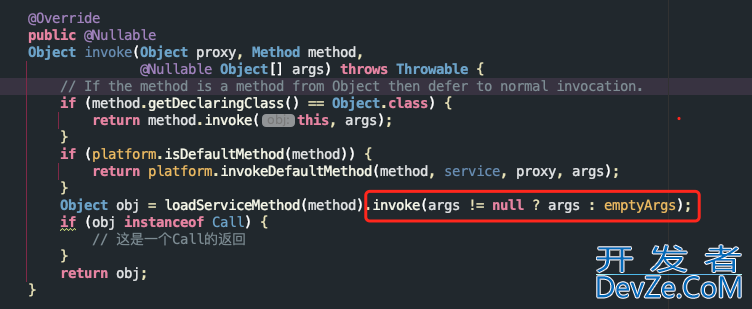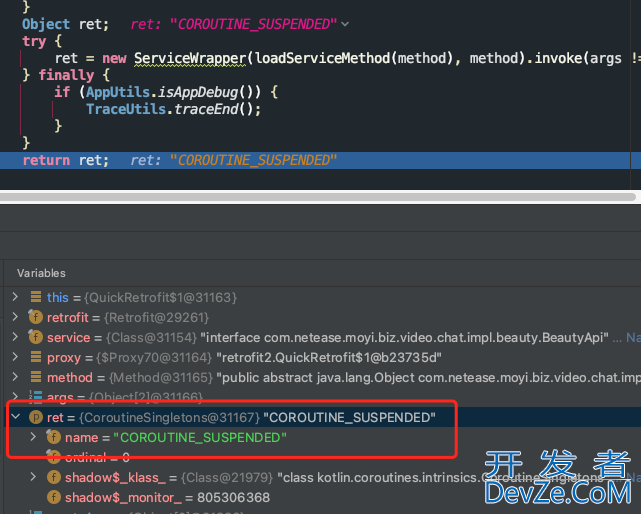目录
- 前言
- Retrofit 的性能问题
- 尝试优化
- 不是AOP的AOP
- 获取 suspend 方法的返回值
- 缓存请求结果
- One more thing?
- 总结
前言
Retrofit 是 Square 公司开源的网络框架,在 android 日常开发中被广泛使用,开发者们对于 Retrofit 的原理、源码都已经android有相当深入的分析。
本文也是从一次简单的性能优化开始,挖掘了 Retrofit 的实现细节,并在此基础上,探索了对 Retrofit 的更多玩法。
因此,本文将主要讲述从发现、优化到探索这一完整的过程,以及过程的一些感悟。
Retrofit 的性能问题
问题源自一次 App 冷启动优化,常规启动优化的思路,一般是分析主线程耗时,然后把这些耗时操作打包丢到IO线程中执行。短期来看这不失是一种见效最快的优化方法,但站在长期优化的角度,也是性价比最低的一种方法。因为就性能优化而言,我们不能仅考虑主线程的执行,更多还要考虑对整体资源分配的优化,尤其在并发场景,还要考虑锁的影响。而 Retrofit 的问题正属于后者。
我们在排查启动速度时发现,首页接口请求的耗时总是高于接口平均值,导致首屏数据加载很慢。针对这个问题,我们使用 systrace 进行了具体的分析,其中一次结果如下图,

可以看到,这一次请求中有大段耗时是在等锁,并没有真正执行网络请求;如果观察同一时间段的其他请求,也能发现类似现象。
那么这里的请求是在等什么锁?配合 systrace 可以在 Retrofit 源码(下文相关源码都是基于 Retrofit 2.7.x 版本,不同版本逻辑可能略有出入)中定位到,是如下的一把锁,
// retrofit2/Retrofit.Java
public <T> T create(final Class<T> service) {
validateServiceInterface(service);
return (T) Proxy.newproxyInstance(service.getClassLoader(), new Class<?>[] { service },
new InvocationHandler() {
@Override public @Nullable Object invoke(Object proxy, Method method,
@Nullable Object[] args) throws Throwable {
...
return loadServiceMethod(method).invoke(args != null ? args : emptyArgs);
}
});
}
ServiceMethod<?> loadServiceMethod(Method method) {
ServiceMethod<?> result = serviceMethodCache.get(method);
if (result != null) return result;
synchronized (serviceMethodCache) { // 等待的锁
result = serviceMethodCache.get(method);
if (result == null) {
result = ServiceMethod.parseAnnotations(this, method);
serviceMethodCache.put(method, result);
}
}
return result;
}
Retrofit 相关的实现原理这里就不再赘述,简而言之 loadServiceMethod 这个方法的作用是:通过请求 interface 的入参、返回值、注解等信息,生成 Converter、CallAdapter,并包装成一个 ServiceMethod 返回,之后会通过这个 ServiceMethod 来发起真正的网络请求。
从上述源码也可以看到,ServiceMethod 是有内存缓存的,但问题也正在这里—— ServiceMethod 的生成是在锁内完成的。
因此问题就变成,生成 ServiceMethod 为什么会有耗时?以云音乐的项目为例,各个团队都是使用 moshi 进行 json 解析,大部分 meta 类是通过 kotlin 实现,但也存在一定 kotlin、 Java 混用的情况。
这部分耗时主要来自 moshi 生成 JsonAdapter。生成 JsonAdapter 需要递归遍历 meta 类中的所有 field,过程中除了 kotlin 反射本身的效率和受并发的影响,还涉及 kotlin 的 builtins 机制,以及冷启动过程中,类加载的耗时。
上述提到的几个耗时点,每一个都可以单开一篇文章讨论,篇幅原因这里一言以蔽之——冷启动过程中,moshi 生成 JsonAdapter 是一个非常耗时的过程(而且这个耗开发者_JAVA入门时,跟使用 moshi 解析框架本身也没有必然联系,使用其他 json 解析框架,或多或少也会遇到类似问题)。
锁+不可避免的耗时,引发的必然结果是:在冷启动过程中,通过 Retrofit 发起的网络请求,会部分劣化成一个串行过程。因此出现 systrace 中呈现的结果,请求大部分时间在等锁,这里等待的是前一个请求生成 ServiceMethod 的耗时,并以此类推耗时不断向后传递。
尝试优化
既然定位到了原因,我们可以尝试优化了。
首先可以从 JsonAdapter 的生成效率入手,比如 moshi 原生就支持 @JsonClass 注解,通过 apt 在编译时生成 meta的 解析器,从而显著减少反射耗时。
二来,还是尝试从根本上解决问题。其实从发现这个问题开始,我们就一直在思考这种写法的合理性:首先加锁肯定是为了访问 serviceMethodCache 时的线程安全;其次,生成 ServiceMethod 的过程时,确实有一些反射操作内部是有缓存的,如果发生并发是有一定性能损耗的。
但就我们的实际项目而言,不同 Retrofit interface 之间,几乎没有重叠的部分,反射操作都是以 Class 为单位在进行。以此为基础,我们可以尝试优化一下这里的写法。
那么,在不修改 Retrofit 源码的基础上,有什么方法可以修改请求流程吗?
在云音乐的项目中,对于创建 Retrofit 动态代理,是有统一封装的。也就是说,项目中除个别特殊写法,绝大多数请求的创建,都是通过同一段封装。只要我们改写了 Retrofit 创建动态代理的流程,是不是就可以优化掉前面的问题?
先观察一下 Retrofit.create 方法的内部实现,可以发现大部分方法的可见性都是包可见的。众所周知,在 Java 的世界里,包可见就等于 public,所以我们可以自己实现 Retrofit.create 方法,写法大概如下,
private ServiceMethod<?> loadServiceMethod(Method method) {
// 反射取到Retrofit内部的缓存
Map<Method, ServiceMethod<?>> serviceMethodCache = null;
try {
serviceMethodCache = cacheField != null ? (Map<Method, ServiceMethod<?>>) cacheField.get(retrofit) : null;
} catch (IllegalAccessException e) {
e.printStackTrace();
}
if (serviceMethodCache == null) {
return retrofit.loadServiceMethod(method);
}
ServiceMethod<?> result = serviceMethodCache.get(method);
if (result != null) return result;
synchronized (serviceMethodCache) {
result = serviceMethodCache.get(method);
if (result != null) return result;
}
synchronized (service) { // 这里替换成类锁
result = ServiceMethod.parseAnnotations(retrofit, method);
}
synchronized (serviceMethodCache) {
serviceMethodCache.put(method, result);
}
return result;
}
可以看到,除了需要反射获取 serviceMethodCache 这个私有成员 ,其他方法都可以直接访问。这里把耗时的 ServiceMethod.parseAnnotations 方法从锁中移出,改为对 interface Class 加锁。(当然这里激进一点,也可以完全不加锁,需要根据实际项目的情况来定)
修改之后,在启动过程中重新抓取 systrace,已经看不到之前等锁的耗时了,首页请求速度也回落到正常区间内。
或许从这也能看出 kotlin 为什么要约束包可见性和泛型的上下边界—— Java 原有的约束太弱,虽然方便了 hook,但同样也说明代码边界更容易被破坏;同时这里也说明了代码规范的重要性,只要保证统一的编码规范,即使不使用什么“黑科技”,也能对代码运行效率实现有效的管控。
不是AOP的AOP
到这里,我们会突然发现一个问题:既然我们都自己来实现 Retrofit 的动态代理了,那不是意味着我们可以获取到每一次请求的结果,乃至控制每一次请求的流程?
我们知道,传统的接口缓存,一般是基于网络库实现的,比如在 okhttp 中的 CacheInterceptor。
这种网络库层级缓存的缺点是:网络请求毕竟是一个IO过程,它很难是面向对象的;并且 Response 的 body 也不能被多次 read,在 cache 过程中,一般需要把数据深拷贝一次,有一定性能损耗。
比如,CacheInterceptor 中就有如下缓存相关的逻辑,在 body 被 read 的同时,再 copy一份到 cache 中。
val cacheWritingSource = object : Source {
var cacheRequestClosed: Boolean = false
@Throws(IOException::class)
override fun read(sink: Buffer, byteCount: Long): Long {
val bytesRead: Long
try {
bytesRead = source.read(sink, byteCount)
} catch (e: IOException) {
if (!cacheRequestClosed) {
cacheRequestClosed = true
cacheRequest.abort() // Failed to write a complete cache response.
}
throw e
}
if (bytesRead == -1L) {
if (!cacheRequestClosed) {
cacheRequestClosed = true
cacheBody.close() // The cache response is complete!
}
return -1
}
sink.copyTo(cacheBody.buffer, sink.size - bytesRead, bytesRead)
cacheBody.emitCompleteSegments()
return bytesRead
}
...
}
但如果我们能整个控制 Retrofit 请求,在动态代理这一层取到的是真正请求结果的 meta 对象,如果把这个对象缓存起来,连 json 解析的过程都可以省去;而且拿到真实的返回对象后,基于对象对数据做一些 hook 操作,也更加容易。
当然,直接缓存对象也有风险风险,比如如果 meta 本身不是 immutable 的,会破坏请求的幂等性,这也是需要在后续的封装中注意的,避免能力被滥用。
那么我们能在动态代理层拿到 Retrofit 的请求结果吗?答案是肯定的。
我们知道 ServiceMethod.invoke 这个方法返回的结果,取决于 CallAdapter 的实现。Retrofit 有两种原生的 CallAdpater,一种是基于 okhttp 原生的 RealCall,一种是基于 kotlin 的 suspend 方法。
也就是说我们在通过 Retrofit 发起网络请求时,一般只有如下两种写法(各个写法其实都还有几个不同的小变种,这里就不展开了)。
interface Api {
@FormUrlEncoded
@POST("somePath")
suspend fun get1(@Field("field") field: String): Result
@FormUrlEncoded
@POST("somePath")
fun get2(@Field("field") field: String): Call<Result>
}
这里 intreface 定义的返回值,其实就是动态代理那里的返回值,

对于返回值为 Call 的写法 ,hook 逻辑类似下面的写法,只要对回调使用装饰器包装一下,就能拿到返回结果或者异常。
class WrapperCallback<T>(private val cb : Callback<T>) : Callback<T> {
override fun onResponse(call: Call<T>, response: Response<T>) {
val result = response.body() // 这里response.body()就是返回的meta
cb.onResponse(call, response)
}
}
但对于 suspend 方法呢?调试一下会发现,当请求定义为 suspend 方法时,返回值如下,

这里的 COROUTINE_SUSPENDED 是什么?
获取 suspend 方法的返回值
要解释 COROUTINE_SUSPENDED 是什么,稍微涉及协程的实现原理。我们可以先看看 Retrofit 本身在生成动态代理时,是怎么适配 suspend 方法的。
Retrofit 中对于 suspend 方法的返回,是通过 SuspendForBody 和 SuspendForResponse 这两个 ServiceMethod 来封装的。两者逻辑类似,我们以 SuspendForBody 为例,
static final class SuspendForBody<ResponseT> extends HttpServiceMethod<ResponseT, Object> {
...
@Override protected Object adapt(Call<ResponseT> call, Object[] args) {
call = callAdapter.adapt(call);
//noinspection unchecked Checked by reflection inside RequestFactory.
Continuation<ResponseT> continuation = (Continuation<ResponseT>) args[args.length - 1];
...
try {
return isNullable
? KotlinExtensions.awaitNullable(call, continuation)
: KotlinExtensions.await(call, continuation);
} catch (Exception e) {
return KotlinExtensions.suspendAndThrow(e, continuation);
}
}
}
首先,代码中的 Continuation 是什么? Continuation 可理解为挂起方法的回调。我们知道,suspend 方法在编译时,会被编译成一个普通的 Java 方法,除了返回值被改写成 Object,它与普通 Java 方法的另一个区别是,编译器会在方法末尾插入一个入参,这个入参的类型就是 Continuation。

可以看到,一个 suspend 方法,在编译之后,多了一个入参。
kotlin 协程正是借助 Continuation 来向下传递协程上下文,再向上返回结果的;所以 suspend 方法真正的返回结果,一般不是通过方法本身的返回值来返回的。
此时,我们只要根据协程状态,任意返回一个占位的返回值即可,比如在 suspendCancellableCoroutine 闭包中,
// CancellableContinuationImpl.kt
@PublishedApi
internal fun getResult(): Any? {
setupCancellation()
if (trySuspend()) return COROUTINE_SUSPENDED
// otherwise, onCompletionInternal was already invoked & invoked tryResume, and the result is in the state
val state = this.state
if (state is CompletedExceptionally) throw recoverStackTrace(state.cause, this)
...
return getSuccessfulResult(state)
}
这也就是前文 COROUTINE_SUSPENDED 这个返回结果的来源。
回到前面 Retrofit 桥接 suspend 的代码,如果我们写一段类似下面的测试代码,会发现这里的 context 与入参 continuation.getContext 返回的是同一个对象。
val ret = runblocking {
val context = coroutineContext // 上一级协程的上下文
val ret = api.getUserDetail(uid)
ret
}
而 Retrofit 中的 KotlinExtensions.await 方法的实现如下,
suspend fun <T : Any> Call<T>.await(): T {
return suspendCancellableCoroutine { continuation ->
continuation.invokeOnCancellation {
cancel()
}
enqueue(object : Callback<T> {
override fun onResponse(call: Call<T>, response: Response<T>) {
if (response.isSuccessful) {
val body = response.body()
if (body == null) {
...
continuation.resumeWithException(e)
} else {
continuation.resume(body)
}
} else {
continuation.resumeWithException(HttpException(response))
}
}
override fun onFailure(call: Call<T>, t: Throwable) {
continuation.resumeWithException(t)
}
})
}
}
结合前面对 Continuation 的了解,把这段代码翻译成 Java 伪代码,大概是这样的,
public Object await(Call<T> call, Object[] args, Continuation<T> continuation) {
编程客栈call.enqueue(object : Callback<T> {
override fun onResponse(call: Call<T>, response: Response<T>) {
continuation.resumeWith(Result.success(response.body));
}
override fun onFailure(call: Call<T>, t: Throwable) {
continuation.resumeWith(Result.failure(t));
}
})
return COROUTINE_SUSPENDED;
}
可以看到,suspend 方法是一种更优雅实现回调的语法糖,无论是在它的设计目的上,还是实现原理上,都是这样。
所以,根据这个原理,我们也可以按类似如下方式 hook suspend 方法,从而获得返回值。
@Nullable
public T hookSuspend(Method method, Object[] args) {
Continuation<T> realContinuation = (Continuation<T>) args[args.length - 1];
Continuation<T> hookedContinuation = new Continuation<T>() {
@NonNull
@Override
public CoroutineContext getContext() {
return realContinuation.getContext();
}
@Overrid
public void resumeWith(@NonNull Object o) {
realContinuation.resumeWith(o); // 这里的object就是返回结果
}
};
args[args.length - 1] = hookedContinuation;
return method.invoke(args);
}
缓存请求结果
到这里已经距离成功很近了,既然我们能拿到每一种请求类型的返回结果,再加亿点点细节,就意味着我们可以实现基于 Retrofit 的预加载、缓存封装了。
Cache 封装大差不差,主要是处理以下这条逻辑链路:
Request -> Cache Key -> Store -> Cached Response
因为我们只做内存缓存,所以也不需要考虑数据的持久化,直接使用Map来管理缓存即可。
- 先封装入参,我们在动态代理层以此入php参为标志,触发预加载或缓存机制,
sealed class LoadInfo(
val id: String = "", // 请求id,默认不需要设置
val timeout: Long // 超时时间
)
// 用来写缓存/预加载
class CacheWriter(
id: String = "",
timeout: Long = 10000
) : LoadInfo(id, timeout)
// 用来读缓存
class CacheReader(
id: String = "",
timeout: Long = 10000,
val asCache: Boolean = false // 未命中时,是否要产生一个新的缓存,可供下一次请求使用
) : LoadInfo(id, timeout)
- 插入 hook 代码,处理缓存读写逻辑,(这里还需要处理并发,基于协程比较简单,这里就不展开了)
fun <T> ServiceMethod<T>.hookInvoke(args: Array<Any?>): T? {
val loadInfo = args.find { it is LoadInfo } as? LoadInfo
// 这里我们可以用方法签名做缓存key,方法签名肯定是唯一的
val id = method.toString()
if (loadInfo is CacheReader) {
// 尝试找缓存
val cache = map[id]
if (isSameRequest(cache?.args, args)) {
// 找到缓存,并且请求参数一致,则直接返回
return cache?.result as? T
}
}
// 正常发起请求
val result = invoke(args)
if (loadInfo is CacheWriter) {
// 存缓存
map[id] = Cache(id, result)
}
return result
}
这里使用 map 缓存请求结果,丰富一下缓存超时逻辑和前文提到的并发处理,即可投入使用。
- 定义请求,
我们可以利用 Retrofit 中的 @Tag 注解来传入 LoadInfo 参数,这样不会影响真正的网络请求。
interface TestApi {
@FormUrlEncoded
@POST("moyi/user/center/detail")
suspend fun getUserDetail(
@Field("userId") userId: String,
@Tag loadInfo: LoadInfo // 缓存配置
): UserDetail
}
- have a try,
suspend fun preload(preload: Boolean) {
launch {
// 预加载
api.getUserDetail("123", CacheWriter(timeout = 5000))
}
delay(3000)
// 读预加载的结果
api.getUserDetail("123", CacheReader()) // 读到上一次的缓存
}
执行代码可以看到,两次 api 调用,只会发起一次真正的网络请求,并且两次返回结果是同一个对象,跟我们的预期一致。
相比传统网络缓存,这种写法的好处,除了前面提到的减少 IO 开销之外,几乎可以做到零侵入,相比常规网络请求写法,只是多了一个入参;而且写法非常简洁,常规写法可能用到的预加载、超时、并发等大量的胶水代码,都被隐藏在 Retrofit 动态代理内部,上层业务代码并不需要感知。当然 AOP 带来的便利性,与动态代理写法的优势也是相辅相成。
One more thing?
云音乐内部一直在推动 Backend-for-Frontend (BFF) 的建设,BFF 与 Android 时下新兴的 MVI 框架非常契合,借助 BFF 可以让 Model 层变的非常简洁。
但 BFF 本身对于服务端是一个比较重的方案,特别对于大型项目,需要考虑 RPC 数据敏感性、接口性能、容灾降级等一系列工程化问题,并且 BFF 在大型项目里一般也只用在一些非 P0 场景上。特别对于团队规模比较小的业务来说,考虑到这些成本后,BFF 本身带来的便利几乎全被抵消了。
那么有什么办法可以不借助其他端实现一个轻量级的 BFF 吗?相信你已经猜到了,我们已经 AOP 了 Retrofit,实现网络缓存可以看作是小试牛刀,那么实现 BFF 也不过是更进一步。
与前文借助动态代理层实现网络缓存的思路类似,我们也选择把 BFF 层隐藏在动态代理层中。
可以先梳理一下大概的思路:
- 使用注解定位需要 BFF 的 Retrofit 请求;
- 使用 apt 生成 BF编程F 需要的胶水代码,将多个普通 Retrofit 请求,合并成一个 BFF 请求;
- 通过 AGP Transform 收集所有 BFF 生成类,建立映射表;
- 在 Retrofit 动态代理层,借助映射表,把请求实现替换成生成好的 BFF 代码。
实际上,目前主流的各种零入侵代码框架(比如路由、埋点、数据库、启动框架、依赖注入等),都是用类似的思路实现的,我们触类旁通即可。
这里为对此思路还不太熟悉的小伙伴,简单过一遍整体设计流程,
首先,定义需要的注解,用 @BFF 来标识需要进行 BFF 操作的 meta 类或接口,
@Retention(RetentionPolicy.CLASS)
@Target({ElementType.FIELD, ElementType.METHOD})
public @interface BFF {
String source() default ""; // 数据源信息,默认不需要
boolean primary() default false; // 是否为必要数据
}
用 @BFFSource 注解来标识数据预处理的逻辑(在大部分简单场景下,是不需要使用此注解的,因此把这部分拆分成一个单独的注解,以降低学习成本),
@Retention(RetentionPolicy.CLASS)
@Target({ElementType.FIELD})
public @interface BFFSource {
Class clazz() default String.class; // 目前数据
String name() default ""; // 别名
String logic() default ""; // 预处理逻辑
}
定义数据源,数据源的写法跟普通 Retrofit 请求一样,只是方法上额外加一个 @BFF 注解作为 apt 的标识,
@JvmSuppressWildcards
interface TestApi {
@BFF
@FormUrlEncoded
@POST("path/one")
suspend fun getPartOne(@Field("position") position: Int): PartOne
@BFF
@FormUrlEncoded
@POST("path/two")
suspend fun getPartTwo(@Field("id") id: Int): PartTwo
}
定义目标数据结构,这里依然通过 @BFF 注解,与前面的请求做关联,
data class MyMeta(
@BFF(primary = true) val one: PartOne,
@BFF val two: PartTwo?
) {
@BFFSource(clazz = PartOne::class, logic = "total > 0")
var valid: Boolean = false
}
定义BFF请求,
@JvmSuppressWildcards
interface BFFApi {
@BFF
@POST("path/all") // 在这个方案中,BFF api的path没有实际意义
suspend fun getAll(
@Field("position") position: Int,
@Field("id") id: Int
): MyMeta
}
通过上述注解,在编译时生成胶水代码如下,(这里生成代码的逻辑其实跟依赖注入是完全一致的,囿于篇幅就不详细讨论了)
public class GetAllBFF(
private val creator: RetrofitCreate,
scope: CoroutineScope
) : BFFSource(scope) {
private val testApi: TestApi by lazy {
creator.create(UserApi::class.java)
}
public suspend fun getAll(
position: Int,
id: Int
): MyMeta {
val getPartOneDeferred = loadAsync { testApi.getPartOne(position) }
val getPartTwoDeferred = loadAsync { testApi.getPartTwo(id) }
val getPartOneResult = getPartOneDeferred.await()
val getPartTwoResult = getPartTwoDeferred.await()
val result = MyMeta(getPartOneResult!!,
getPartTwoResult)
result.valid = getPartOneResult!!.total > 0
return result
}
}
在使用时,直接把 BFF api 当作一个普通的接口调用即可,Retrofit 内部会完成替换。
private val bffApi by lazy {
creator.create(BFFApi::class.java)
}
public suspend fun getAllMeta(
position: Int,
id: Int
): MyMeta {
return bffApi.getAll(position, id) // 直接返回BFF合成好的结果
}
可以看到,与前文设计接口缓存封装类似,可以做到零侵入、零胶水代码,使用起来非常简洁、直接。
总结
至此,我们回顾了对于 Retrofit 的性能问题,从发现问题到解决问题的过程,并简单讲解了我们是怎么进一步开发 Retrofit 的潜力,以及常用的低侵入框架的设计思路。文章涉及的基于 Retrofit 的缓存、BFF 设计,更多是抛砖引玉,而且不仅仅是 Retrofit,大家掌握类似的设计思路之后,可以把它们应用在更多场景中,对于日常的开发、编码效率提升和性能优化,都会很有帮助,希望对各位能有所启发,更多关于魔改Retrofit实例的资料请关注我们其它相关文章!









 加载中,请稍侯......
加载中,请稍侯......
精彩评论